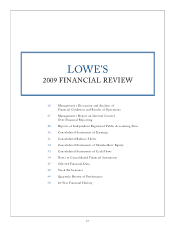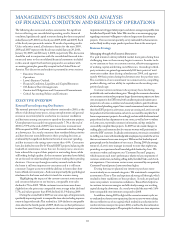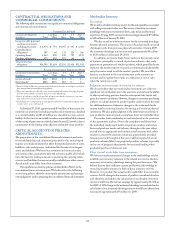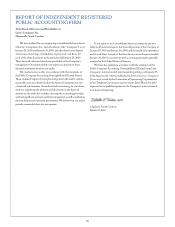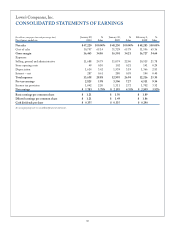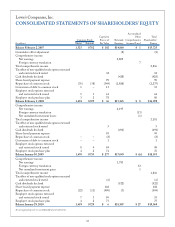Lowe's 2009 Annual Report Download - page 29
Download and view the complete annual report
Please find page 29 of the 2009 Lowe's annual report below. You can navigate through the pages in the report by either clicking on the pages listed below, or by using the keyword search tool below to find specific information within the annual report.
27
We speak throughout this Annual Report in forward-looking statements
about our future, particularly in the “Letter to Shareholders” and
“Management’s Discussion and Analysis of Financial Condition and
Results of Operations.” e words “believe,” “expect,” “will,” “should,” and
other similar expressions are intended to identify those forward-looking
statements. While we believe our expectations are reasonable, they are
not guarantees of future performance. Our actual results could differ
substantially from our expectations because, for example:
• Our sales are dependent upon the health and stability of the general
economy, which we believe is recovering slowly from a prolonged
period of recession that was made worse by the severe accompanying
financial/credit crisis. Continued high rates of unemployment,
the psychological effect of falling home prices, reduced access to
credit and reduced consumer confidence have combined to lead
to sharply reduced consumer spending, particularly on many of the
discretionary, bigger-ticket products we sell. In addition, changes
in the level of repairs, remodeling and additions to existing homes,
changes in commercial building activity, and the availability and
cost of mortgage financing can impact our business.
• Major weather-related events and unseasonable weather may
negatively impact our sales particularly of seasonal merchandise.
Prolonged and widespread drought conditions could, for example,
hurt our sales of lawn and garden and related products.
• Our expansion strategy is impacted by economic conditions,
environmental regulations, local zoning issues, availability and
development of land, and more stringent land-use regulations.
Furthermore, our ability to secure a highly qualified workforce
is an important element to the success of our expansion strategy.
• Our business is highly competitive, and, as we build an increasing
percentage of our new stores in larger markets and utilize new sales
channels such as the internet, we may face new and additional
forms of competition. Promotional pricing and competitor
liquidation activities during challenging economic periods such
as we are continuing to experience may increase competition and
adversely affect our business.
• e ability to continue our everyday low pricing strategy and
provide the products that customers want depends on our vendors
providing a reliable supply of products at competitive prices and
our ability to effectively manage our inventory. As an increasing
number of the products we sell are imported, any restrictions or
limitations on importation of such products, political or financial
instability in some of the countries from which we import them, or a
failure to comply with laws and regulations of those countries from
which we import them could interrupt our supply of imported inven-
tory. e current global recession from which we are beginning to
recover and credit crisis that continues to some extent have adversely
affected the operations and financial stability of some of our ven-
dors by reducing their sales and restricting their access to capital.
• Our goal of increasing our market share and our commitment
to keeping our prices low requires us to make substantial
investments in new technology and processes whose benefits
could take longer than expected to be realized and which could
be difficult to implement and integrate.
• Changes in existing or new laws and regulations that affect
employment/labor, trade, product safety, transportation/logistics,
energy costs, health care, tax or environmental issues, could
have an adverse impact, directly or indirectly, on our financial
condition and results of operations.
For more information about these and other risks and uncertainties
that we are exposed to, you should read the “Risk Factors” included in
our Annual Report on Form 10-K to the United States Securities and
Exchange Commission. All forward-looking statements in this report
speak only as of the date of this report or, in the case of any document
incorporated by reference, the date of that document. All subsequent
written and oral forward-looking statements attributable to us or any
person acting on our behalf are qualified by the cautionary statements in
this section and in the “Risk Factors” included in our Annual Report on
Form 10-K. We do not undertake any obligation to update or publicly
release any revisions to forward-looking statements to reflect events,
circumstances or changes in expectations after the date of this report.
DISCLOSURE REGARDING
FORWARDLOOKING STATEMENTS
Management of Lowe’s Companies, Inc. and its subsidiaries is
responsible for establishing and maintaining adequate internal
control over financial reporting (Internal Control) as defined in
Rule 13a-15(f) under the Securities Exchange Act of 1934, as amended.
Our Internal Control was designed to provide reasonable assurance to
our management and the Board of Directors regarding the reliability
of financial reporting and the preparation and fair presentation of
published financial statements.
All internal control systems, no matter how well designed, have
inherent limitations, including the possibility of human error and the
circumvention or overriding of controls. erefore, even those systems
determined to be effective can provide only reasonable assurance with
respect to the reliability of financial reporting and financial statement
preparation and presentation. Further, because of changes in conditions,
the effectiveness may vary over time.
Our management, with the participation of the Chief Executive
Officer and Chief Financial Officer, evaluated the effectiveness of our
Internal Control as of January 29, 2010. In evaluating our Internal
Control, we used the criteria set forth by the Committee of Sponsoring
Organizations of the Treadway Commission (COSO) in Internal
Control – Integrated Framework. Based on our management’s assess-
ment, we have concluded that, as of January 29, 2010, our Internal
Control is effective.
Deloitte & Touche LLP, the independent registered public
accounting firm that audited the financial statements contained in
this report, was engaged to audit our Internal Control. eir report
appears on page 29.
MANAGEMENT’S REPORT ON INTERNAL CONTROL
OVER FINANCIAL REPORTING


